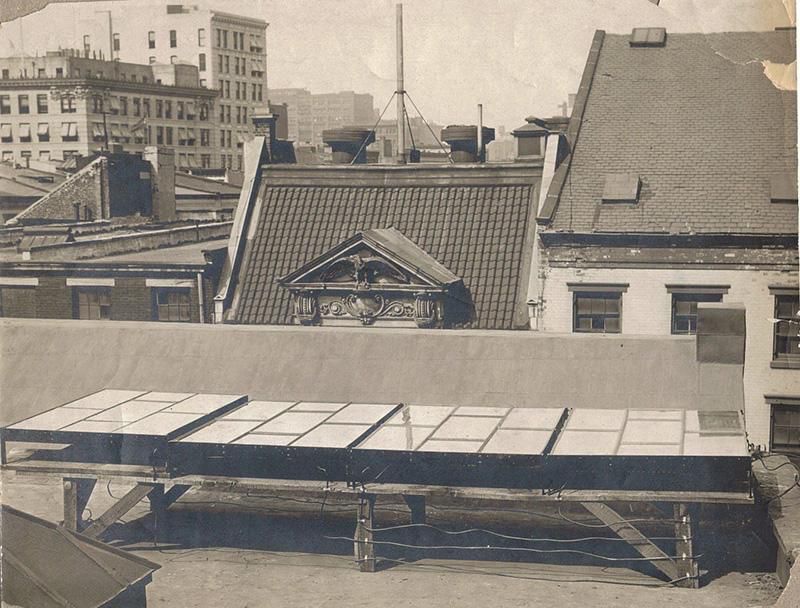
The development of solar cell technology, or photovoltaic (PV) technology began when, in 1839, French physicist Alexandre Edmond Becquerellar first demonstrated the ability of a solar cell to convert sunlight into electricity – the photovoltaic effect.
In 1866, a brilliant mathematician, another French, Augustin Mouchot built a solar-powered steam engine using a concave mirror to reflect the sun’s rays onto a glass-covered boiler. Mouchot also created the world’s largest parabolic solar collector, which was revealed at the World Expo in Paris in 1878.
In 1883, Charles Fritts created the first solar cell by coating selenium with a thin layer of gold. The selenium module produced a current “that is continuous, constant, and of considerable force”, with an energy conversion rate of 1 to 2 percent. It was a low impact solar cell, nonetheless, the birth of innovation of photovoltaics in the United States. Fritts installed the first solar panels on a New York City rooftop in 1884.

Photo Credit: smithsonianmag.com
In the 1800s, Italian physicist Alessandro Volta invented the first electric battery – the ‘voltaic pile’ which was the predecessor of the modern day battery.
Photovoltaics, the study of photon energy-electric current conversion, is from the Greek word phōs (light) and the word volt, the unit for electrical potential (voltage), named after Volta.
In 1888, Edward Weston filed for and received two patents for solar cells. Weston proposed, “to transform radiant energy derived from the sun into electrical energy, or through electrical energy into mechanical energy.”

Photo Credit: smithsonianmag.com
That same year, Russian scientist Alexander Stoletov also built a solar cell on the principle of the outer photoelectric effect discovered by the German physicist Heinrich Rudolf Hertz. Photoelectric effect happens when light falls on a material and electrons are released. Stoletov also discovered the sensitivity decrease of solar cells over time which is now commonly referred to as photovoltaic degradation.
Today, solar cells use the photoelectric effect to convert sunlight into power.
In 1894, Melvin L. Severy received the first-ever patent for a solar cell.

Photo Credit: smithsonianmag.com
Almost 10 years later, American inventor Harry Reagan applied and received patents for thermal batteries – the “application of solar heat to thermo batteries.” Essentially, Reagan invented a means to collect, store and distribute solar heat as needed.
In 1913, American William Coblentz invented an electric current generator using light. His patent was not for a solar panel, but for a thermal generator. The thermal generators convert heat directly into electricity or transform that energy into power for heating and cooling.
In the 1950s, Daryl Chapin, Calvin Fuller, and Gerald Pearson of Bell Laboratories created a solar cell that was 6% efficient using materials such as silicon.
In 1973, University of Delaware built a structure called “Solar One” which ran on a combination of solar thermal and solar photovoltaic power. The design used solar cells (not solar panels) to convert solar energy into electricity and heat, and used a heat pump for auxiliary heating and air conditioning.

Photo Credit: research.udel.edu
In the 1970s, an energy crisis emerged in the United States. The federal government seeing solar power as a potential solution to the energy crisis, committed to develop solar energy. Congress passed the Solar Energy Research, Development and Demonstration Act of 1974 which ordered the installation of solar heating and cooling units in federal buildings by 1977. The goal was “to make solar viable and affordable and market it to the public.”
Congress passed the Public Utility Regulatory Policies Act of 1978, which, among other things, laid the foundation for future net metering policies. Through the Energy Tax Act of 1978, Congress also created the commercial investment tax credit (ITC) and the residential energy credit (or residential ITC) to provide financial incentives for the public to purchase solar properties. The residential energy credit was calculated at 30% of the first $2,000 spent on qualifying solar expenditures, and 20% of the next $8,000 spent on solar for a maximum of $2,500.
Beginning January 1, 2020, the federal tax credit for installing solar is at 26%.
Currently, several states are solar markets – New Jersey, Massachusetts, Pennsylvania, Maryland, District of Columbia, Ohio, Delaware, North Carolina, California, Illinois. These states offer Solar Renewable Energy Certificates (SRECs). Resulting from state laws requiring utilities to produce a specific percentage of their electricity from renewable resources, SRECs are a solar incentive that allows homeowners to sell certificates for energy to their utility.
In a 2017 solar cost benchmark report by National Renewable Energy Laboratory’s (NREL), the cost for residential solar panel systems has dropped a remarkable 61% since 2010.
Today, Building-Integrated Photovoltaics (BIPV) and Building-Applied Photovoltaics (BAPV) are also increasingly being incorporated into the construction of new buildings and retrofitted into existing ones. BIPV and BAPV are photovoltaic materials used to replace conventional building materials in parts of the building envelope such as the roof, skylights, or facades.
The goal is to put solar energy financially on par (grid parity) with other energy sources by the year 2020.
The current solar industry standard warranty is 25 years, guaranteeing panel performance of above 80% of their rated efficiency. A solar energy system installed today can last between 30 and 50 years.
With the long history of constant improvements in the technology combined with current global direction towards grid-parity, solar industry’s promise of clean and sustainable energy is here to stay.

